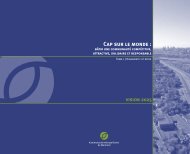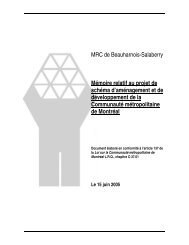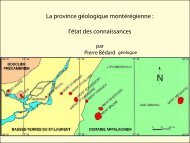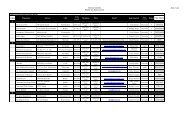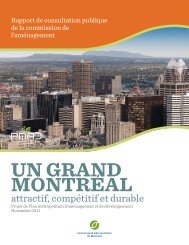Portrait of the Greater Montréal, 2010 edition - Communauté ...
Portrait of the Greater Montréal, 2010 edition - Communauté ...
Portrait of the Greater Montréal, 2010 edition - Communauté ...
Create successful ePaper yourself
Turn your PDF publications into a flip-book with our unique Google optimized e-Paper software.
2006-2031 outlook: Demographic growthstimulated primarily by internationalimmigration in <strong>the</strong> centre <strong>of</strong> <strong>the</strong> area, andby intraprovincial migration and naturalgrowth on <strong>the</strong> North and South ShoresAccording to projections by <strong>the</strong> Institut de la statistiquedu Québec, demographic growth between 2006 and 2031should be stimulated primarily by international immigration,especially in <strong>the</strong> area’s centre (<strong>the</strong> Montréal agglomeration),but also in Longueuil agglomeration and Laval. On <strong>the</strong>North and South Shores, however, natural growth andintraprovincial migration should continue to be <strong>the</strong> mainengines <strong>of</strong> demographic growth.Central sectors losing populationto <strong>the</strong> outskirtsWhile <strong>the</strong> great majority <strong>of</strong> immigrants choose <strong>the</strong> Montréalagglomeration as <strong>the</strong>ir place <strong>of</strong> residence, every yearMontréal Island loses part <strong>of</strong> its population to <strong>the</strong> o<strong>the</strong>rgeographic sectors <strong>of</strong> <strong>the</strong> area. Laval and <strong>the</strong> Longueuilagglomeration, although benefiting from positive netmigration flows with Montréal Island, are also losing some<strong>of</strong> <strong>the</strong>ir population to <strong>the</strong> North and South Shores.This “leap-frog” urbanization dynamic extends to <strong>the</strong>area adjoining 3 <strong>Greater</strong> Montréal, which posts positivenet migration with <strong>Greater</strong> Montréal, especially with <strong>the</strong>Montréal agglomeration and <strong>the</strong> North and South Shores.demographicsComponents <strong>of</strong> projected demographicgrowth, 2006-2031, <strong>Greater</strong> Montréal’s fivegeographic sectorsAnnual average net migration: <strong>Greater</strong> Montréalsectors, area adjoining <strong>Greater</strong> Montréal and rest <strong>of</strong>Quebec, 2000-2009MontréalagglomerationLavalLongueuilagglomerationNorthShoreSouthShoreNatural growthNet intraprovincialmigrationNet interprovincialmigrationNet internationalmigration15- 750,000 - 500,000 - 250,000 0 250,000 500,000 750,000 1,000,000(Number <strong>of</strong> people)Source: Institut de la statistique du Québec, Perspectives démographiquesdu Québec et des régions, 2006-2056, édition 2009.Calculations by <strong>the</strong> CMM, <strong>2010</strong>.Montréalagglo.Longueuilagglo.LavalNorthShoreSouthShoreAdjoiningmunicipalitiesRest <strong>of</strong>QuebecMontréalagglomeration... -2,490 -6,790 -4,650 -4,310 -1,620 370Longueuilagglomeration2,490 ... -30 -150 -1,870 -630 -510Laval 6,790 30 ... -3,100 -140 -700 -420North Shore 4,650 150 3,100 ... 40 -1,560 -480South Shore 4,310 1,870 140 -40 ... -1,340 -600Adjoiningmunicipalities1,620 630 700 1,560 1,340 ... -20Rest <strong>of</strong>Quebec-370 510 420 480 600 20 …Source: Institut de la statistique du Québec, special compilation based on <strong>the</strong>insured persons registration file (FIPA) <strong>of</strong> <strong>the</strong> Régie de l’assurance maladie duQuébec (RAMQ). Calculations by <strong>the</strong> CMM, <strong>2010</strong>.3 As is <strong>the</strong> case on page 16, <strong>the</strong> area adjoining <strong>Greater</strong> Montréal here includes <strong>the</strong> 56 municipalities covered by Origin-Destination Survey 2008 not forming part <strong>of</strong> <strong>the</strong>CMM, <strong>the</strong> six municipalities outside <strong>the</strong> CMM belonging to <strong>the</strong> Rouville RCM (which Highway 10 and Route 112 cross), <strong>the</strong> ten o<strong>the</strong>r municipalities bordering <strong>the</strong>CMM, and Joliette and Saint-Hyacin<strong>the</strong>, two regional hubs less than 15 kilometres from CMM boundaries. Overall, <strong>the</strong>se municipalities adjacent to <strong>Greater</strong> Montréalrepresented a population <strong>of</strong> 556,000 in 2006.



